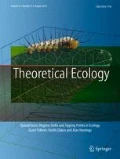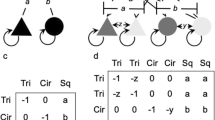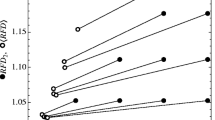Abstract
The theoretical exploration of how diversity influences stability has traditionally been approached by species-centric methods. Here we offer an alternative approach to the diversity–stability problem by examining the stability and dynamics of size and trait distributions of individuals. The analysis is performed by comparing the properties of two size spectrum models. The first model considers all individuals as belonging to the same “average” species, i.e., without a description of diversity. The second model introduces diversity by further considering individuals by a trait, here asymptotic body size. The dynamic properties of the models are described by a stability analysis of equilibrium solutions and by the non-equilibrium dynamics. We find that the introduction of trait diversity expands the set of parameters for which the equilibrium is stable and, if the community is unstable, makes the oscillations smaller, slower, and more regular. The stabilizing mechanism is the variation in growth rate between individuals with the same body size but different trait values.







Similar content being viewed by others
References
Andersen KH, Beyer JE, (2006) Asymptotic body size determines species abundance in the marine size spectrum. Am Nat 168:54–61
Andersen KH, Beyer JE, Lundberg P (2009) Trophic and individual efficiencies of size-structured communities. Proc R Soc B 276:109–114
Andersen KH, Pedersen M (2010) Damped trophic cascades driven by fishing in model marine ecosystems. Proc R Soc B 277:795–802
Benoît E, Rochet MJ (2004) A continuous model of biomass size spectra governed by predation and the effects of fishing on them. J Theor Biol 226:9–21
Blanchard JE, Jennings S, Law R, Castle MD, McCloghrie P, Rochet MJ, Benoît E (2009) How does abundance scale with body size in coupled size-structured food webs? J Anim Ecol 78:270–280
Boudreau PR, Dickie LM (1992) Biomass spectra of aquatic ecosystems in relation to fisheries yield. Can J Fish Aquat Sci 49:1528–1538
Brooks JL, Dodson SI (1965) Predation, body size, and composition of plankton. Science 150:28–35
Brose U, Williams RJ, Martinez ND (2006) Allometric scaling enhances stability in complex food webs. Ecol Lett 9:1228–1236
Capitán JA, Delius GW (2010) Scale-invariant model of marine population dynamics. Phys Rev E 81:061901
Chambers RC (1997) Environmental influences on egg and propagule sizes in marine fishes. In: Chambers RC, Trippel EA (eds) Early life history and recruitment in fish population. Chapman and Hall, London, pp 63–102
Cohen JE, Pimm SL, Yodzis P, Saldana J (1993) Body sizes of animal predators and animal prey in food webs. J Anim Ecol 62:67–78
Cohen JE, Jonsson T, Carpenter SR (2003) Ecological community description using the food web, species abundance, and body size. Proc Natl Acad Sci U S A 100:1781–1786
Cross MC, Hohenberg PC (1993) Pattern formation outside of equilibrium. Rev Mod Phys 65:851–1112
Datta S, Delius GW, Law R (2010) A jump-growth model for predator–prey dynamics: derivation and application to marine ecosystem. Bull Math Biol 72:1361–1382
Datta S, Delius GW, Law R, Plank MJ (2011) A stability analysis of the power-law steady state of marine size spectrum. J Math Biol. doi:101007/s00285-010-0387-z
Dunne JA, Brose U, Williams RJ, Martinez ND (2005) Modeling food web dynamics: complexity–stability implications. In: Belgrano A, Scharler U, Dunne JA, Ulanowicz RE (eds) Aquatic food webs. Oxford University Press, New York, pp 117–129
Gross T, Rudolf L, Levin SA, Dieckmann U (2009) Generalized models reveal stabilizing factors in food webs. Science 325:747–750
Hofbauer J, Sigmund K (1988) The theory of evolution and dynamical systems. Cambridge University Press, Cambridge
Hartvig M, Andersen KH, Beyer JE (2011) Food web framework for size-structured populations. J Theor Biol 272:113–122
Jennings S, Mackinson S (2003) Abundance–body mass relationships in size-structured food webs. Ecol Lett 6:971–974
Kerr SR, Dickie LM (2001) The biomass spectrum: a predator–prey theory of aquatic production. Columbia University Press, New York
Kondoh M (2003) Foraging adaptation and the relationship between food-web complexity and stability. Science 299:1388–1391
Kuznetsov YA (1994) Elements of applied bifurcation theory. Springer, New York
Law R, Morton RD (1993) Alternative permanent states of ecological communities. Ecology 74:1347–1361
Law R, Plank MJ, James A, Blanchard JL (2009) Size-spectra dynamics from stochastic predation and growth of individuals. Ecology 90:802–811
May RM (1972) Will a large complex system be stable. Nature 18:413–414
McCann K, Hastings A, Huxel GR (1998) Weak trophic interactions and the balance of nature. Nature 395:794–798
McKendrick AG (1926) Applications of mathematics to medical problems. P Edinburgh Math Soc 44:98–130
Oksanen L, Fretwell SD, Arruda J, Niemela P (1981) Exploitation ecosystems in gradients of primary productivity. Am Nat 2:264–261
Peters R (1983) The ecological implications of body size. Cambridge University Press, Cambridge
Plank MJ, Law R (2011) Ecological drivers of stability and instability in marine ecosystems. Theor Ecol. doi:10.1007/s12080-011-0137-x
Rice J, Gislason H (1996) Patterns of change in the size-spectra of numbers and diversity of the North Sea fish assemblage, as reflected in surveys and models. ICES J Mar Sci 53:1214–1225
Rochet MJ, Benoît E (2011) Fishing destabilizes the biomass flow in the marine size spectrum. Proc R Soc B. doi:10.1098/rspb.2011.0893
Sheldon RW, Parsons T (1967) A continuous size spectrum for particulate matter in the sea. J Fish Res Board Can 24:909–915
Sheldon RW, Prakash A, Sutcliffe WHJ (1972) The size distribution of particles in the ocean. Limnol Oceanogr 17:327–340
Sheldon RW, Sutcliffe WH, Paranjape MA (1977) Structure of pelagic food chain and relationship between plankton and fish production. J Fish Res Board Can 34:2344–2353
Shin YJ, Rochet MJ, Jennings S, Field JG, Gislason H (2005) Using size-based indicators to evaluate the ecosystem effects of fishing. ICES J Mar Sci 62:384–396
Silvert W, Platt T (1978) Energy flux in the pelagic ecosystem: a time-dependent equation. Limnol Oceanogr 23:813–816
Ursin E (1973) On the prey size preferences of cod and dab. Medd Dan Fisk Havunders, New Ser 7:84–98
von Foerster H (1959) Some remarks on changing populations. In Stohlman F (editor) The kinetics of cellular prolifeation. Grune and Stratton, New York, pp 381–407
Yodzis P (1981) The stability of real ecosystems. Nature 289:674–676
Yodzis P, Innes S (1992) Body size and consumer-resource dynamics. Am Nat 6:1151–1175
Acknowledgements
Ken Haste Andersen acknowledges financial support from EU FP7 project FACTS. Martin Hartvig is kindly acknowledged for helpful discussions. We greatly thank the reviewers for constructive comments on this paper.
Author information
Authors and Affiliations
Corresponding author
Appendices
Appendix 1: Boundary condition
We derive the lower boundary condition N(m b,M) in the trait-based model on the basis of equilibrium size spectrum (ESS) theory (Andersen and Beyer 2006). Moreover, we assume that the total offspring recruitment in the trait-based model equals the recruitment in the community model, that is,
The ESS theory involves two assumptions. On one hand, the community size spectrum is of a power law state, that is, \(\overline{N}_{\rm c}(m)=\kappa m^{-\uplambda}\). On the other hand, the feeding level, indicating the mount of energy routed to individual somatic growth, is constant. Under these two conditions, Andersen and Beyer (2006) found the analytical solution to Eq. 1
where a = β 2n − q − 1/α is the physiological predation rate and k 0 a constant satisfying \(\int_m^{\infty} \overline{N}(m,M){\rm d}M = \kappa m^{-\uplambda}\). The exponent of community size spectrum is found to be \(\uplambda = 2+q-n\). Due to Eq. 11, the lower boundary condition is set as
Therefore, f 0 is calculated by evaluating
Since resource spectrum is fixed, encountered food of offspring can be calculated analytically
Note that \(\uplambda =2\) when q = n. Thus, E(m b) is independent of the width of selection function σ and the preferred predator–prey mass ratio β.
Appendix 2: Averaging growth efficiency
The average of growth efficiency is calculated based on the ESS theory, and our calculation is in principle a replicate of Andersen and Beyer (2006) and Andersen et al. (2009). In order for completeness, we present it here briefly.
The ESS theory assumes an infinite size range for community size spectrum, i.e., \(\overline{N}_{\rm c}(m) = {km}^{-\uplambda}, \ 0< m < \infty\). The advantage is that we can get a closed form when doing integration to obtain individual encountered food (Eq. 15) and mortality (Eq. 18), whereas in our trait-based model and community model, size spectrum is, however, truncated for numerical calculations. The individual encountered food can be calculated as
where \(\alpha_e =\gamma \beta^{\uplambda-2}e^{(\uplambda-2)^2\sigma^2/2}\). Thus, individual somatic growth rate is
According to Eqs. 12 and 16, the average growth rate is calculated as
where the coefficient α c is to be determined.
The mortality rate is
where \(\alpha_p = \gamma \kappa e^{(1+q-\uplambda)^2\sigma^2/2}\beta^{1+q-\uplambda}\). Inserting the average growth rate (Eqs. 16 and 18) into the stationary equation of Eq. 10, we obtain
By solving the equation (Eq. 19), the exponent of the community size spectrum is found to be \(\uplambda = n + \alpha_p/\alpha_{\rm c}\). Notice that \(\uplambda = 2+q-n\), and then α c = α p / (2 + q − 2n).
Dividing Eqs. 17 by 15, the average growth efficiency is
Appendix 3: Tracing equilibrium and determining stability
To solve the non-equilibrium dynamics to the trait-based size-spectrum model, we refer readers to Hartvig et al. (2011) where detailed numerical program is included and the key point is how to discretize the McKendrick–von Foerster equation which is presented in Eq. 21. Analogously, the dynamics of the community size spectrum can also be solved. In the following, the focus is how to continuously trace equilibrium solution as a function of a free parameter (e.g., the diet width σ). To this end, we apply Newton’s parameter continuation (Kuznetsov 1994) combined with the semi-implicit upwind scheme (Hartvig et al. 2011). Since body size spans several orders of magnitude, logarithmical size is preferred. Details of the logarithmical transformation can be referred to Benoît and Rochet (2004). We describe our technical approach by taking the community model as an example.
Discretization
Set x = log(m) and discretize x as x i = log(m b) + Δx, i = 0, ⋯ , k, where x k < log(M b) < x k + 1. In addition, let \(u_i^t = u(x_i, t)\Delta x = N(m(x_i))m(x_i)\Delta x\) represent the total number of individuals in the range of [x i − 1, x i ]. Then the discretization of the McKendrick–von Foerster Eq. 10 can be described as follows:
where
and
Set \(U^t = (u_1^t, \cdots, u_k^t)^{\prime}\), \(B = (\frac{\Delta t}{\Delta x}g_0 u_0, 0, \cdots, 0)^{\prime}\), where the subscript indicates the transpose of a matrix or a vector. g 0 is completely determined by the resource spectrum and thus constant.
Equation 21 has an equivalent form
where A(U) is a do-bidiagonal matrix and along the main and lower diagonals are vectors a = (a i ) and b = (b i ), respectively. Moreover, the entries in these two vectors are
and
SetF(U): = A(U t)U t + Δt − U t − B. Making an explicit dependence of F on the free parameter leads to
Newton’s continuation
Now it is ready to perform the Newton’s continuation using Eq. 27. Detailed description is referred to Kuznetsov (1994). We here present how to calculate the Jacobian matrix of Eq. 27 for given equilibrium U and σ.
Define dFdU to be the Jacobian matrix, which is of k 2 dimension, and set c j to be a row vector of dimension k whose entries are all zero except for the j-th component which is exactly 1. The dFdU can be calculated as follows: Noticing the special structure of the matrix A(U), the first row of the Jacobian is
and for j > 1
where dg j /dU and dμ j /dU are row vectors with the following form:
To calculate the derivative of F with respect to the free parameter, we use the forward finite difference as an approximation, i.e.,
where δ = max {σδ 1, δ 2}.
Implementation of the parameter continuation in the trait-based model is similar but more challenging. Apart from the discretization along the direction of individual body size, the trait is also discretized evenly on the logarithmical scale. Thus, the matrix in Eq. 24 is now a black don-bidiagonal of K 2 dimension with \(K=\sum_{i=1}^{L}k_i\), where k i is the number of discretized points for species i and L is the number of discretized species. Each block matrix has the same structure as the matrix in Eq. 24 with entries Eqs. 25 and 26.
After some initial experimentation, we found that setting \(\Delta x =0.1, \Delta t= 0.02, \delta_1 = 10^{-4}, \delta_1 = 10^{-7}, L = 20\) could produce reliable result without causing too much computational effort, even though the precise choice of discretization affects the resolution of the approximation.
Determining the stability of equilibrium
In analogy to Eq. 21, discretization of the McKendric–von Foerster equation at given equilibrium U gives rise to
where g i and μ i are similar with Eqs. 22 and 23. Rewriting the right-hand side of Eq. 33 as a matrix leads to
where A s and B s are similar to A and B but the entries are \(-\frac{a_i-1}{\Delta t}\) and \(-\frac{b_i}{\Delta t}\) in A s and B/Δt in B s. The Jacobian matrix of G(U) with respect to U can be calculated in analogy to Eqs. 28 and 29. Stability of equilibrium U is determined through the maximum real part of the Jacobian matrix of G(U) with positive value meaning unstable and vice versa.
Rights and permissions
About this article
Cite this article
Zhang, L., Thygesen, U.H., Knudsen, K. et al. Trait diversity promotes stability of community dynamics. Theor Ecol 6, 57–69 (2013). https://doi.org/10.1007/s12080-012-0160-6
Received:
Accepted:
Published:
Issue Date:
DOI: https://doi.org/10.1007/s12080-012-0160-6




